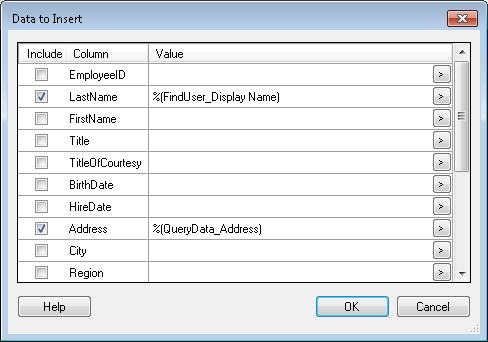Insert Data
This activity inserts the specified rows into a database.
![]() How does this activity look in the Designer Pane?
How does this activity look in the Designer Pane?
- Drag it from the Toolbox Pane and drop it in the Designer Pane.
To configure this activity
-
 Activity Name
Activity Name
Once added to a workflow definition, the default name of an activity can be changed. Providing a custom name for an activity helps you remember the role it plays.
To name an activity
- Add an activity to your workflow by dragging it from the Toolbox Pane and dropping it in the Designer Pane.
- Select the activity in the Designer Pane.
- Under
 Activity Name in the Properties Pane,
replace the default name.
Activity Name in the Properties Pane,
replace the default name.
Note: Activity names cannot be the same as any other activity name in the workflow, they cannot be the same as the workflow's name, they must be less than 100 characters, they must contain at least one alphanumeric character, they cannot be "Name," and they cannot be the same as the activity's runtime type (which is usually only an issue with custom activities).
-
 Activity Description
Activity Description
Use the Activity Description to provide descriptive text to help you remember the role that the activity plays in the workflow. All activities contain a default description that you can modify while constructing your workflow.
To modify an activity description
- Add an activity to your workflow by dragging it from the Toolbox Pane and dropping it in the Designer Pane.
- Select the activity in the Designer Pane.
- Under
 Activity Description in the Properties Pane, replace the default description.
Activity Description in the Properties Pane, replace the default description.
-
 Data Source
Data Source
This property box determines which data source the activity will use.
To select a data source
- Add a Custom Query, Insert Data, Query Data, or Update Data activity to your workflow definition by dragging it from the Toolbox Pane and dropping it in the Designer Pane.
- Select the activity in the Designer Pane.
- Under
 Data Source in the Properties Pane, select a data source from the drop-down menu.
Data Source in the Properties Pane, select a data source from the drop-down menu. - Optional: To add, configure, remove, or test a connection to an external data source, select Manage Data Sources from the drop-down menu. More information.
- Optional: Click the refresh icon
 to update the list of data sources available in the drop-down menu.
to update the list of data sources available in the drop-down menu.
Note: Because the Workflow Server performs the data-source queries, you must create all data sources on the Workflow Server. Services cannot access mapped drives when you are setting up the data source.
-
 Data to Insert
Data to Insert
This property box determines what row values will be inserted into a database with the Insert Data activity.
Note: You must configure the Data Source property box before configuring this property box.
To configure Data to Insert
- Add the Insert Data activity to your workflow definition by dragging it from the Toolbox Pane and dropping it in the Designer Pane.
- Select the activity in the Designer Pane.
- Under
 Data to Insert in the Properties Pane, select a table from the drop-down menu.
Data to Insert in the Properties Pane, select a table from the drop-down menu. - Optional: Click Refresh to update the list of tables, if you have made changes to the data source.
- Optional:Click Create Identity Token to retrieve the identifier of the inserted rows.
- Click Set Values or anywhere in the dark gray box, to open the
 Data to Insert dialog box.
Data to Insert dialog box. - Select the boxes next to the Columns for which you want to specify values in the inserted row. Hold down the SHIFT or CTRL key to select multiple rows at once.
- Type in a value next to the Columns you selected, or click the Token button (right arrow)
 to use tokens.
to use tokens. - Click OK.
Tip: To replace a token that has a blank value with "DB.NULL," apply the NULL token formatting expression.To always set a column's value to "DB.NULL", insert "%(DB.NULL)".
-
 Query Options
Query Options
This property box allows you to specify a custom timeout for data query activities.
To specify a custom timeout
- Add a Custom Query, Insert Data, Query Data, or Update Data activity to your workflow definition by dragging it from the Toolbox Pane and dropping it in the Designer Pane.
- Select the activity in the Designer Pane.
- Under
 Query Options in the Properties Pane, select the Specify a custom timeout check box and specify the desired timeout value in seconds.
Query Options in the Properties Pane, select the Specify a custom timeout check box and specify the desired timeout value in seconds.
Note: The default timeout value is 30 seconds.






